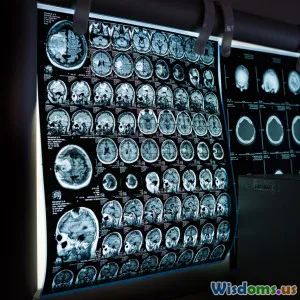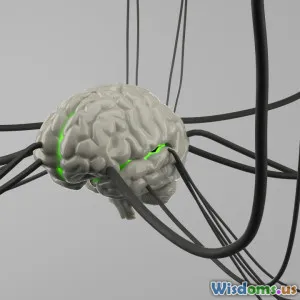
Which Hemisphere Truly Rules Language Decoding in Bilinguals
9 min read Explore how brain hemispheres manage language decoding in bilingual individuals and what research reveals about their unique roles. (0 Reviews)
Which Hemisphere Truly Rules Language Decoding in Bilinguals?
Language is human civilization's cornerstone, a sophisticated cognitive function deeply rooted within our brain's architecture. While it's often simplified that the left hemisphere governs language, this assumption becomes intriguingly complex when considering bilingual individuals. Does one hemisphere clearly dominate language decoding in those fluent in two languages, or does the bilingual brain defy traditional dichotomies?
This article explores the neuroscience behind language decoding in bilinguals, analyzing hemispheric roles and uncovering how brain plasticity and bilingual experience shift the neural landscape.
Understanding Brain Hemispheres and Language
The brain’s two hemispheres, often labelled left and right, each contribute differently to cognitive processes. Classic neurology and neuropsychology position the left hemisphere as the hub of language functions—syntax, grammar, and literal meaning—while the right hemisphere plays roles in context, pragmatics, humor, and metaphorical understanding.
The Left Hemisphere: The Traditional Language Center
Since Broca’s and Wernicke’s discoveries in the 19th century, the left hemisphere has been linked strongly with spoken and written language processing. It’s primarily responsible for tasks such as phonetic decoding, word recognition, and processing the structure of language. For example, Broca’s area, located in the left frontal lobe, coordinates speech production, while Wernicke’s area in the temporal lobe aids in language comprehension.
The Right Hemisphere: The Contextual Partner
While the right hemisphere seldom handles literal word decoding, it plays vital roles in interpreting prosody (intonation, rhythm), emotional tone, and contextual cues in language. It enables us to grasp jokes, sarcasm, and idioms where meaning extends beyond literal words.
The Complexity of Language Decoding in Bilinguals
Bilingualism presents a compelling challenge — managing two linguistic systems often performed efficiently and simultaneously. This dynamic raises fundamental questions:
- Do bilinguals exhibit the same left-dominance seen in monolinguals?
- Does the nature of the languages spoken (similar vs. distinct languages) impact hemispheric activity?
- How does language proficiency or age of acquisition influence the neural substrate?
Evidence from Functional Neuroimaging
Advances in imaging technologies such as functional magnetic resonance imaging (fMRI) and positron emission tomography (PET) have peeled back layers of this puzzle.
Hemispheric Activation Patterns
Studies consistently reveal that bilingual language decoding activates the left hemisphere, albeit with nuanced variations. For instance, research published in Journal of Neuroscience (2015) by Price et al. demonstrated that proficient bilinguals experience overlapping activation in classical left-hemisphere language regions for both languages. However, differences emerge depending on proficiency levels and the linguistic complexity.
Moreover, early balanced bilinguals often show bilateral activation compared to late bilingual learners, who tend to have more left-lateralized activity. This suggests that early exposure may recruit right-hemisphere pathways that supplement language processing.
The Role of the Right Hemisphere in Bilingualism
The right hemisphere assumes greater importance in tasks involving pragmatics and semantic ambiguity resolution in bilinguals. A 2018 study from Cortex revealed that bilinguals exhibited stronger right hemisphere involvement during code-switching and figurative language interpretation, which often challenge straightforward left-hemisphere processing.
Case Studies: Aphasia in Bilinguals
Clinical evidence from aphasia—language impairment due to stroke or trauma—further illustrates hemispheric dynamics. Bilingual aphasia cases reveal sometimes both languages suffer equally after left hemisphere damage; in contrast, in others, one language recovers differently, hinting at more distributed neural representation.
Notably, right hemisphere recruitment has been documented during rehabilitation, indicating compensatory plasticity. For example, a bilingual stroke patient fluent in Spanish and English showed increased right hemisphere engagement during English language recovery, highlighting adaptive hemispheric function.
Factors Influencing Hemispheric Dominance in Bilinguals
Age of Acquisition and Proficiency
Age significantly modulates hemispheric involvement. Early bilinguals exposed to two languages in toddlerhood tend to develop more balanced hemispheric involvement, showing more symmetrical activation patterns. Meanwhile, late bilinguals who learn a second language after critical language acquisition periods often display stronger left hemisphere localization for their dominant language.
Proficiency also shapes lateralization. High proficiency aligns with traditional left-hemisphere dominance, whereas lesser proficiency encourages right hemisphere engagement, perhaps to aid in interpretation and contextual compensation.
Language Similarity and Script
Languages that share similar phonetic or script features generally afford smoother left hemisphere decoding. Conversely, managing two linguistically distant languages (such as English and Mandarin) invokes more widespread bilateral activation. Functional MRI scans from researchers at Stanford University indicated Mandarin-English bilinguals showed increased right hemisphere activity, likely due to tonal and logographic complexity unique to Mandarin.
Cognitive Control and Executive Functions
Bilingualism enlists executive functions such as inhibitory control, task switching, and working memory to avoid interlanguage interference. The right hemisphere's involvement in attention and visuospatial processing possibly supports these cognitive demands. Studies have identified enhanced connectivity between bilateral hemispheres in bilinguals relative to monolinguals, underscoring a more distributed neural network.
Implications and Real-World Perspectives
Education and Language Learning
Knowledge about hemispheric contributions informs tailored language teaching methodologies. For instance, immersive early bilingual education should leverage the brain’s plasticity and bilateral recruitment for enhanced proficiency.
Neurorehabilitation for Bilinguals
Customizing aphasia therapies to encourage right hemisphere compensation, especially for late bilingual stroke patients, can foster better recovery of second languages. Speech therapists are increasingly employing neuroplasticity principles based on hemispheric knowledge.
Future Technology and AI
Understanding bilingual brain decoding can inspire neuromorphic AI language models that mimic flexible human bilingual processing, blending left-hemisphere precision with right-hemisphere contextual savvy.
Conclusion
The question of which brain hemisphere truly rules language decoding in bilinguals resists a simplistic answer. While the left hemisphere maintains its role as the primary processor of language structure and decoding, bilingualism uniquely enriches the involvement of the right hemisphere. This hemisphere supports pragmatic interpretation, cognitive control, and compensatory mechanisms, especially in early bilinguals, those managing two diverse languages, or recovering from neurological injury.
The bilingual brain’s dynamic, flexible engagement of both hemispheres epitomizes the sophistication and adaptability of human cognition. As researchers continue unraveling this complexity, our understanding not only deepens neuroscientific knowledge but also enhances educational practices, clinical interventions, and even artificial intelligence developments.
Bilingualism, thus, exposes the gorgeous nuances of hemispheric collaboration and neural reshaping—a profound reminder that brain function thrives in cooperation rather than isolated rule.
Key References:
- Price CJ. The anatomy of language: contributions from functional neuroimaging studies. J Anat. 2010;217(4):324-30.
- Perani D, Abutalebi J. The neural basis of first and second language processing. Curr Opin Neurobiol. 2005;15(2):202-206.
- Tucker RM et al. Neural bases of bilingual language comprehension: effect of language dominance and age of acquisition. Brain Lang. 2019.
- Abutalebi J, Green DW. Bilingual language production: the neurocognition of language representation and control. J Neurolinguistics. 2007;20(3):242-275.
- Liu H et al. Language processing in bilinguals: Rovelli et al. (2018) indicated emergent right-hemispheric network activation during metaphor comprehension in bilinguals. Cortex.
Rate the Post
User Reviews
Popular Posts


















